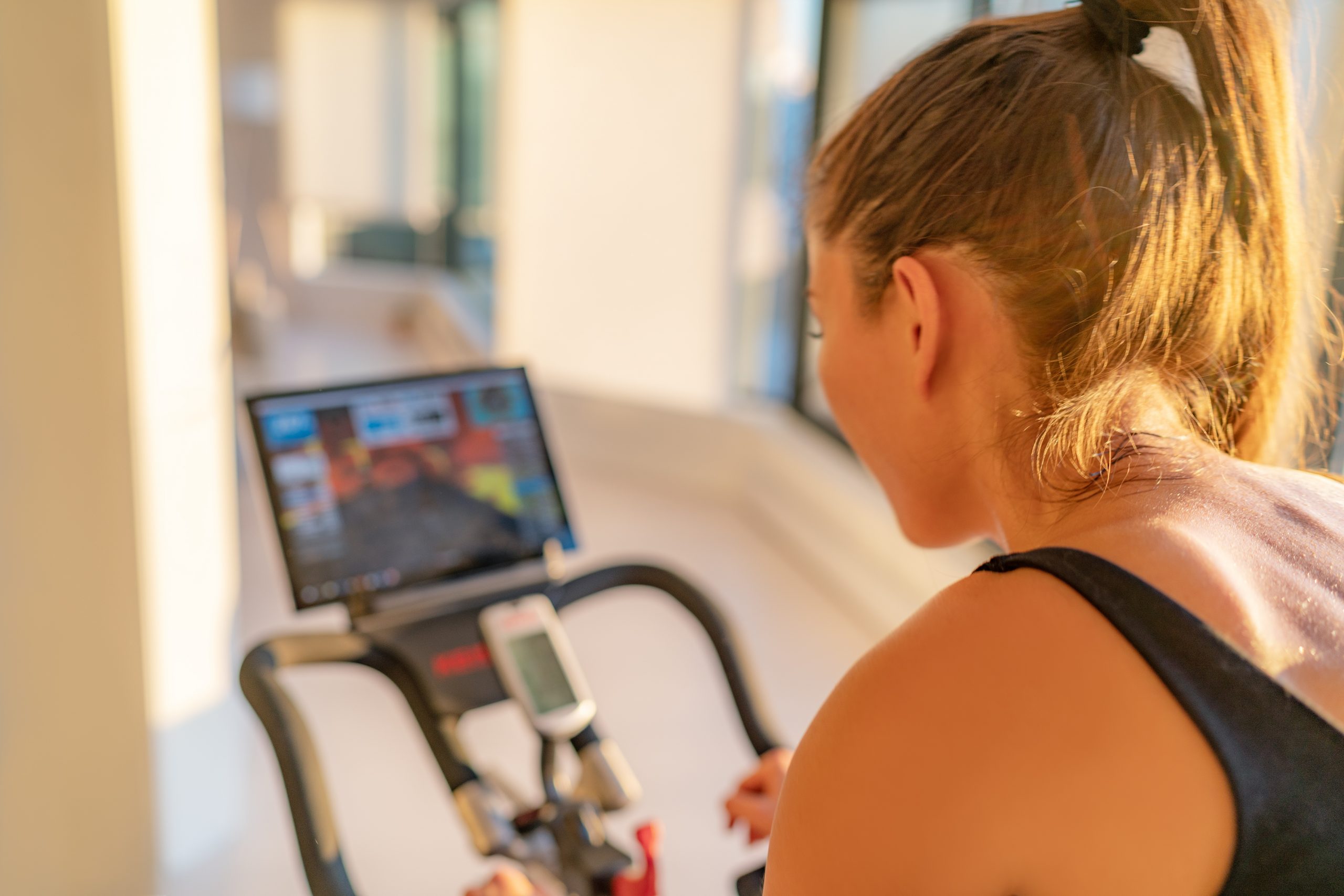Since the last lockdown, there has been a huge increase in home exercising and in particular indoor cycling. Generally, this is fabulous as indoor cycling is a great way to get an exhilarating, low impact, cardio heavy workout without leaving your front room. BUT, if you are not careful, it can you leave with number of overuse injuries, aches and pains. Post lockdown, I have seen a huge number of clients, complaining of neck, shoulder , lower back and knee pain and a huge proportion of these have been caused by or aggravated by poor indoor cycling technique or overuse. So, following a request from an actual client who aggravated her upper back pain after spending weeks on her new indoor bike, I’ve created a list of common issues and simple ways to avoid or minimise these issues. Check these out and hopefully they will help!
KNEE PAIN – Cyclists knee , aka Patellofemoral pain syndrome, is an overuse condition caused by repetitive friction between the thigh bone and the knee cap. It can be caused by poor mobility at the hip which forces the knee to work harder.
How can we avoid this?
- If you are a beginner, start small and gradually increase the intensity and duration of your workouts and pay particular attention to this if you already suffer with arthritis or have had previous knee issues.
- Make sure that your bike is set up correctly.
- The seat should be hip height when you stand next to it – if it is too low then your knees will take an additional strain by failing to properly extend, if too high then you will be hyperextending your knee at the bottom of the pedal stroke
- There should be enough distance between the seat and handlebars to allow you to have a soft bend at the elbow, whilst keeping length in the spine
- Aim for a 30 degree bend in the knee when the pedal is at the bottom
- Make sure that your resistance is not too high or you will be putting too much load on your knee joint. Your speed should never be lower than 60rpms. Be careful though that the resistance is not too low as this puts you at risk of falling of your bike .
- Make sure that you are not only pushing down on the pedals but also sweeping the foot back and up at the bottom of each pedal stroke.
LOWER BACK PAIN – This is another common problem. if you think about the standard cycling position where you are leaning over with your feet strapped in and a reliance on your core to keep you upright and stable, then this alone will cause stress to your lower back which will be worse if you are already injured or have a weak core.
How can we avoid this?
- Make sure that your handlebars are the right height. If they are too low you will end up hunching over or “crowding” the handlebars, arching your back and thus causing low back pain. Keep your chest wide and open, with a straight back and dropped shoulders
- Make sure that your seat is the correct height – if your hips drop to either side as you pedal, so when you pedal with your left , your left hip drops and ditto on the right, then you are overreaching and your pelvis will be shifting, which will cause stress in your lower back.
- Incorporate core stability and strength work into your workout routine. Strong core muscles will keep your back straight
- Avoid uncontrolled bouncing around in your seat, especially if the class is a high energy, crazy choreography type class. Poor form will almost certainly result in back pain.
UPPER BACK, NECK , SHOULDER PAIN – This is another common problem that many of my clients suffer with regardless of their “Peloton” habit. If you are somebody with a history of upper back , neck or shoulder pain then you should be especially careful here. Good posture and bike set up will be key to avoiding issues here.
- Check your position. If you are poking your chin forward, arching your back and holding your head up for too long, to check out your phone or video monitor, then you will be placing stress and constant compression on the back of your neck. Keep changing your neck and head position in a controlled way , ensure that your chest is wide and open and drop your shoulders.
- Incorporate neck and shoulder mobility exercises into your daily routine.
- As before, make sure that your handlebars are the right height, if they are too low this will cause tension on the neck, shoulders and back.
- Make sure that you are not putting top much weight on your handlebars. You should be using your core to keep you upright.
- Make sure that you are not shrugging or hunching your shoulders when you ride. Keep your shoulders down and imagine that you are pulling the handlebars apart when you are riding , which will help lock the shoulders into the right position.
HIP PAIN – caused by inflammation of a hip tendon (hip tendonitis). When we cycle on a stationary bike, our feet are locked into the pedals and so we have limited ability to move our leg at hip level which can cause overuse and inflammation of hip tendons.
So how can we avoid this?
- Warm up properly
- Vary your rides as much as possible, stand up , sit down, change the cadence, intensity and duration of each ride
In addition to the above , follow these rules to keep your indoor cycling and general home exercising pain free.
- Warm up effectively before the work-out
- Cool down and stretch after the workout
- Rest and recover between sessions
- if you are a beginner , start slowly and build up intensity and duration gradually
- Cross train – add strength and flexibility drills to your workout routine with a key focus on core stability, hip mobility and glute strength
- Be extra careful if you pre existing aches , pains or injuries
- Watch your form . Good technique is everything!
- Finally and most important, if you feel pain , don’t ignore it and try and ride through it. Make sure you get it fixed!!




